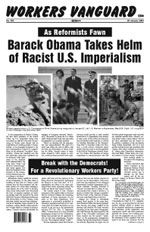
Devastation in Motor City Reporter's Notebook A longtime cadre, Vance, went to major auto plants in Detroit in mid-December to distribute Workers Vanguard with the front-page article “Bosses Declare War on UAW Workers” (5 December 2008). He was accompanied by two longtime SL sympathizers from the Detroit area. Printed below is his report, edited for publication, of the trip. Soon after I arrived, Matt and I went to the Ford plant in Dearborn. We found the large automobile assembly facility no longer existed. This was the place where we have done sales for years as part of our subscription drive. All that’s left is the truck assembly plant. We sold 33 copies of Workers Vanguard. This was pretty good considering the windchill was about zero and it was completely drive-by traffic. The workers on the day shift were overwhelmingly white, about 80 percent from what I saw. The second shift had more black workers, about 40 percent. There was one incident where a white couple drove in, bought a paper, turned around in the parking lot, drove up to me, and the woman handed me a fistful of ones, said thank you and then sped off. White or black, a good number of the workers didn’t like what United Auto Workers (UAW) president Ron Gettelfinger was doing, selling out the workers again so that the Big Three carmakers could get government bailouts. One black worker said, “It’s embarrassing what he’s doing, begging.” Most of the workers would at least throw us a “thumbs up” as they drove by. I am sure auto workers feel very besieged these days as the bourgeois media has pointed to their living standards as the main culprits in capitalist decay. So any sign of support, including from us Marxists, is welcomed. The next morning Matt and I hit the Chrysler Truck plant in north suburban Warren. At least the wind cooperated so we only had zero degrees to deal with. These workers probably sense the Sword of Damocles over their heads more than most auto workers, as the company they work for is in very bad shape. We sold 21 papers to a pretty small workforce (maybe 150 to 200 people). This was all walk-up traffic. A couple of guys bought two papers each, an extra one to leave lying around the break area. The suburbs surrounding Detroit resemble suburbs around Chicago, with strip malls and chain restaurants. Once you hit the city, things worsen qualitatively. You can see two and three story buildings just fallen down on themselves. In many instances there are no buildings at all, just open space. As Matt and I drove around we did a little “ghoul tour.” As we crossed streets, he would bring up places where comrade so-and-so was mugged or robbed or where so-and-so was shot. Comrades, Detroit was always kind of rough. Matt had called us in Chicago a few weeks ago, saying that, if Detroit was going down, at least let’s sell to some plants before they’re closed forever. He thinks that Michigan, as a region, is home to the greatest concentration of unemployed skilled workers in the world. Matt told me he was surprised when he recently found out Detroit’s population was now less than 800,000. When he moved there in 1973 there were close to two million people. It’s now a question of how much worse this city can get. Any little string of hope is grasped at. The latest hope is Democratic mayor Ken Cockrell Jr. This is what it has come down to: the son of one of the original leaders of the League of Revolutionary Black Workers has been put into power to rebound the city from former mayor Kwame Kilpatrick. When GM built the Cadillac plant in Hamtramck, “Poletown,” that was indeed ballyhooed as a savior. Matt told me how all these grand plans were drawn up. Nothing except the plant was ever built. The most striking thing about the plant is that the area around it looks like Appalachia, when, at least in warmer weather, you can see poor little white kids playing in the dirt and mud in the adjacent neighborhood. The last plant we sold to was Cadillac on Tuesday afternoon. By now we also had Tom with us. We were able to sell two introductory subscriptions to white guys, one of whom had lots of questions about the military. In all, we sold 35 papers at this location. One woman, a shop steward, told us she was “not happy at all what the union was doing!” While the lack of any fightback from the UAW is pissing off the rank and file, there is nothing people think they can do about it. When I brought up Obama and the Democrats, black workers thought that the new government had to be better than Bush, but there wasn’t euphoria. The few whites I spoke with didn’t say much. What people did respond to was the point about organizing the unorganized, particularly auto workers in the South, including in the foreign-owned plants. This point did elicit a few protectionist comments from people. But others thought it would be a good idea if those workers got the same benefits they had. After things had wound down and Tom was giving me a ride to the airport, he recalled how back in 1985, in response to a call from the UAW Solidarity House to assist striking mineworkers, he was part of a union caravan named “Motown to Coaltown” of hundreds of cars down the interstates to West Virginia. He told me, “Man, with that many cars, each with two or three guys, that’s an army! That’s what needs to be done now to organize the South.” Today, it’s qualitatively the same bureaucracy running the UAW. But a quarter century later, the most they can muster is a promise to the bosses to give up virtually everything in two years and sell out the workers.
|
|
|||||||||||||||||||||||||||||||||||||||||||||||||||||||||
